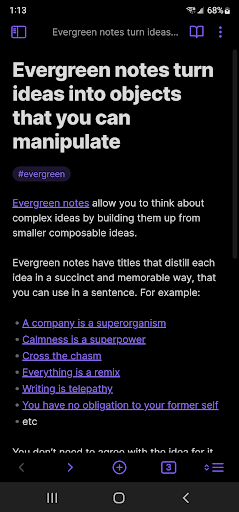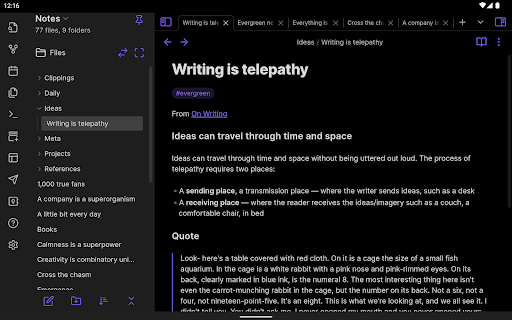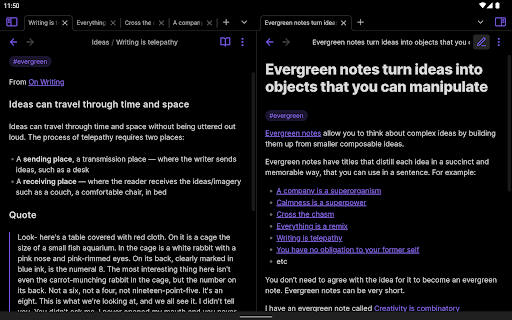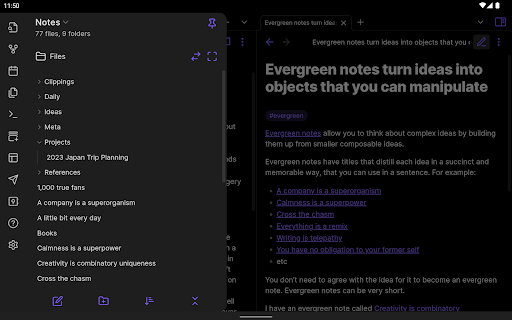| Obsidian ★ 4 |
|
| ⚙️Developer | Dynalist Inc. |
| ⬇️Downloads | 100,000,000+ |
| 📊Category | Productivity |
Obsidian is a note-taking and knowledge management app that has gained popularity among individuals looking for a powerful tool to organize and connect their ideas. With its unique approach to note-taking and emphasis on interlinking thoughts, Obsidian provides a versatile platform for creating a personal knowledge base and fostering creative thinking. By leveraging the power of markdown and backlinking, Obsidian enables users to create a web of interconnected notes, facilitating a deeper understanding of complex topics and fostering knowledge discovery.
Features & Benefits
- Markdown-based Note Taking: Obsidian utilizes markdown, a lightweight markup language, as its primary format for note-taking. Markdown allows users to format text, create headings, lists, and tables, and add links and images with simple syntax. This approach provides a clean and distraction-free writing environment while still offering flexibility and control over the appearance of the notes.
- Backlinking and Interconnected Notes: One of Obsidian’s key features is its ability to create bidirectional links between notes, known as backlinks. Backlinks enable users to establish connections between ideas and navigate their knowledge base more effectively. By simply mentioning a note within another note, Obsidian automatically creates a backlink, allowing users to explore related concepts and discover new insights within their notes.
- Graph Visualization: Obsidian visualizes the relationships between notes through a graph view. This graph provides a visual representation of the interconnectedness of your ideas, helping you identify clusters of related information and uncover hidden connections. The graph view offers a unique and intuitive way to explore your knowledge base and gain a broader perspective on your ideas.
- Customizable and Extensible: Obsidian is highly customizable, allowing users to tailor the app to their specific needs. Users can create custom themes, define keyboard shortcuts, and extend the app’s functionality through community-developed plugins. This flexibility ensures that Obsidian can adapt to different workflows and preferences, making it a versatile tool for a wide range of users.
- Local Storage and Privacy: Obsidian stores all your data locally on your device, ensuring that your notes and personal information remain private and secure. Unlike cloud-based note-taking apps, Obsidian gives you full control over your data and allows you to choose where and how you store your notes. This feature is particularly valuable for individuals who prioritize data privacy and want to keep their knowledge base offline.
Alternative Apps
Turtl:?Turtl is a privacy-focused note-taking app that offers end-to-end encryption and features like markdown support, organization, and collaboration.
Evernote:?Evernote is a widely used note-taking app that offers rich text editing, cross-platform syncing, and robust organizational features.
Bear:?Bear is a beautifully designed note-taking app for Apple devices, featuring a clean interface, markdown support, and easy organization.
OneNote:?OneNote is Microsoft’s note-taking app that provides a digital notebook-like experience with robust features for capturing, annotating, and organizing information.
Pros & Cons
Frequently Asked Questions
Obsidian is a powerful knowledge management tool designed to help users create, organize, and link their notes in a way that mimics the human brain’s thought processes. It uses a networked approach to note-taking, allowing users to build a personal knowledge base by interconnecting their notes through links, tags, and backlinks. This structure makes it easier to discover relationships between ideas and enhances overall productivity. Creating links between notes in Obsidian is straightforward. To link to another note, simply type double square brackets around the name of the note you want to link to. For example, typing `[[Note Title]]` in your current note will create a clickable link to “Note Title”. If the note does not exist yet, clicking the link will prompt you to create a new note with that title. Additionally, you can link to specific headings within a note using the syntax `[[Note Title#Heading]]`. Yes, Obsidian allows you to organize your notes into folders for better management. You can create folders directly within the file explorer pane of the sidebar. Simply right-click in the pane, select “New Folder,” and give it a name. You can then drag and drop notes into these folders to keep related content together. This hierarchical structure enables easy navigation through your knowledge base. Absolutely! Obsidian offers extensive customization options for its user interface. You can choose from a variety of community themes available in the Obsidian marketplace, which allow you to change colors, fonts, and overall aesthetics. Additionally, you can customize CSS snippets if you have coding experience or use plugins to further enhance functionality and appearance. Plugins are additional features that extend the core capabilities of the Obsidian app. They come in various forms and can enhance functionalities such as task management, calendar integration, daily notes, and more. To install a plugin, navigate to “Settings” > “Community Plugins,” toggle off Safe Mode, and browse or search for plugins that suit your needs. Each plugin typically comes with its own set of instructions for configuration and usage. Yes, Obsidian supports multi-device access, but it requires a manual setup as it doesn¡¯t sync notes automatically like some other applications. You can use cloud storage services like Dropbox, Google Drive, or Obsidian Sync (a paid service) to keep your vaults synced across different devices. By storing your vault in one of these services, you can edit your notes seamlessly on any device that has access to the same vault directory. Backlinks are an essential feature of Obsidian, allowing users to see all the notes that link back to the current note. When you link to another note, Obsidian automatically generates a backlink in that note, creating a two-way connection. This is particularly useful for tracing thoughts, making connections between concepts, and navigating your knowledge base efficiently. You can view backlinks in the sidebar, which helps you explore related information easily. Tags in Obsidian serve as a method for categorizing your notes, providing a quick way to group related content. You can add tags by typing `#tagname` anywhere in your notes, and they become searchable. Tags make it easier to filter and find notes on specific topics without having to navigate through folders. Moreover, you can combine tags with links and backlinks to create a more interconnected knowledge system.What is the primary purpose of the Obsidian app?
How do I create links between notes in Obsidian?
Can I organize my notes into folders in Obsidian?
Is there a way to customize the appearance of Obsidian?
What are plugins, and how do they enhance Obsidian’s functionality?
Can I access my notes on multiple devices using Obsidian?
How do backlinks work in Obsidian, and why are they useful?
What is the significance of tags in Obsidian?
Screenshots
 |
 |
 |
 |





